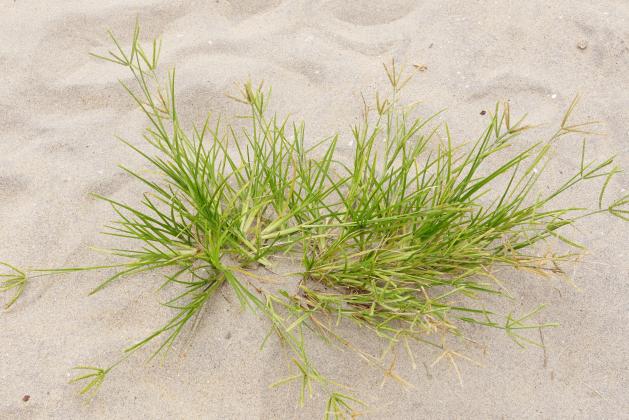Ants store seeds in underground nests
Backyard Horticulture
Dactyloctenium aegyptium, crowfoot grass, is easily recognizable because of its seedhead that resembles a bird’s foot or helicopter blades. There are usually from two to seven spikes arranged horizontally at the top of the stem. That arrangement is called digitate, resembling fingers. The genus name, Dactyloctenium, is from Greek daktylos, finger and ktenos, comb. The digitate inflorescence has a comb-like arrangement. Aegyptium indicates Egypt. D. aegyptium is native to Africa but has naturalized in warm areas of the world including Grimes County.
Crowfoot grass, in the Poaceae, grass family, has stems about 1 ½ feet tall that are round and hollow except at the nodes. It has several branches that are not obvious because most of the plant is usually hidden among other grasses. Leaves are alternate with the lower part attached directly to the stem. It has horizontal runners that spread along the ground. The stem roots at the lower nodes. The plant is drought-resistant, reseeds readily and is not harmed by insects. Seeds, about 1 mm long, are white or green, turning dark brown when ripe. They remain viable for up to 19 years. Seeds may continue to ripen after harvesting. Crushed green seeds are used as a fish stupefier making the fish easy to catch.
Traditionally juice of fresh plants was used for skin conditions, as an antimicrobial, anti-inflammatory, for fever, diarrhea, etc. Dried seeds were eaten by women suffering from after-birth abdominal pain. It is interesting that after-birth abdominal pain in cattle and sheep is mentioned in a National Institutes of Health, ncbi.nlm.nih.gov, article, “Ethnobotanical studies of fodder grass resources for ruminant animals, based on the traditional knowledge of indigenous communities in Central Punjab Pakistan.” D. aegyptium is in the Food and Drug Administration Poisonous Plant Database at fda.gov.
The plant is used as fodder. Seeds are eaten by poultry, rabbits, etc. When ready for harvest, seeds will fall easily into your hand when you pull. A few days later others will be ready. Eating unripe seeds will cause upset stomach but humans eat the ripe seeds raw and cooked as cereal. Beer is also made. Seeds store well for many years and are ground into flour to make unleavened bread used in African and Indian cuisine. Some ants store seeds in underground nests. In times of famine, people have dug up the seeds and eaten them.
The U.S. Department of Agriculture National Agricultural Library, pubag.nal.usda.gov, has more information about ants and crowfoot grass in Mexico. The article is “Doves kleptoparasitize ants.” Kleptoparasitism is when one animal takes food that was caught or collected by another. Ants carried crowfoot grass and other seeds to their nests. Doves waited near the entry of the ants’ nest and took the seeds. Over a period of five days, researchers said the doves took 20 percent of the seeds. The doves are defined as facultative kleptoparasites. You now have a name to call someone who takes your food from the refrigerator without permission.
Deborah Richardson is a freelance reporter for The Examiner with a fondness for flora in its natural setting.


